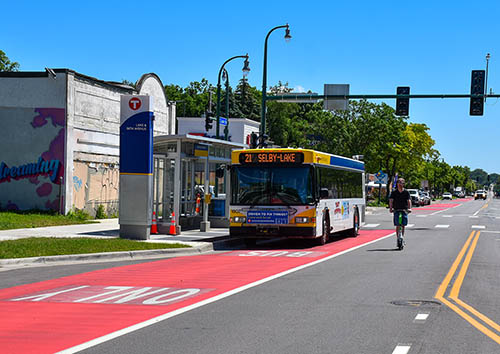 Metro Transit and local partners are expanding the use of bus lanes, signal technology, and other tactics to improve transit reliability across the region.
Metro Transit and local partners are expanding the use of bus lanes, signal technology, and other tactics to improve transit reliability across the region.
The latest advance comes from the installation of bus lanes on sections of sections of Hennepin and Lyndale avenues, which will help thousands of riders on routes 4 and 6 avoid delays as they travel through the busy corridor every day. The project is a partnership between Metro Transit and the City of Minneapolis.
In recent years, bus lanes have also been added to sections of East Lake Street, 7th Street, and Chicago Avenue. Bus lanes will be added to sections of Hennepin and First avenues northeast, Lagoon Avenue and more of Lake Street this year and Minnesota's first bus rapid transit line operating primarily within bus-only lanes, the METRO Gold Line, opens in March 2025.
“Bus lanes are an effective way of increasing transit’s appeal because they help get riders where they want to go faster and more reliably,” General Manager Lesley Kandaras said. “We welcome the addition of bus lanes on Hennepin and Lyndale avenues and look forward to continuing to deploy tools that help improve the transit experience.”
On Hennepin Avenue South, a bus lane pilot decreased travel times by up to 18% during rush hour and by more than 50% on snow days.
In most instances, bus lanes are being added as part of a wider investment in new bus rapid transit lines that keep buses moving through a combination of signal priority, off-board fare payments, all-door boarding, and wider stop spacing.
Three new bus rapid transit lines will open in 2025, including the METRO E Line that will serve the Hennepin Avenue corridor.
Coordinated effort to improve local service
In corridors like Lyndale Avenue, where transit is often delayed and no near-term bus rapid transit investment is planned, improvements are being coordinated through Metro Transit’s Better Bus Routes program.
Through this program, efforts are made to consolidate stops, add shelters, improve bus stop accessibility, and simplify service so local routes are easier and more convenient to use. Improvements have been made to five corridors since the program began in 2018.
Improvements to Route 4, serving Johnson Street in Northeast Minneapolis and Lyndale and Penn avenues in south Minneapolis and Richfield, are being made this fall. Changes to routes 7, 61, and 11, among others, will occur in the coming years.
Metro Transit, partners working collaboratively
Metro Transit works closely with cities, counties, and the Minnesota Department of Transportation, which control traffic signals and street design, to identify and implement changes that make transit more reliable.
A working group formed in 2023 brought multiple stakeholders together to assess current conditions and determine what more could be done in the future (review the group’s findings here).
Metro Transit has expanded its work unit devoted to advancing speed and reliability initiatives with the help of local partners, particularly in corridors where road construction is planned.